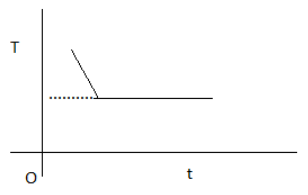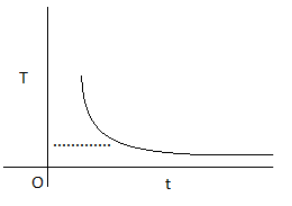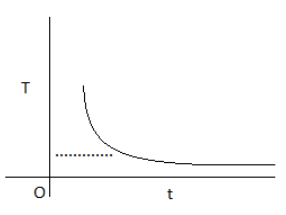
If a piece of metal is heated to temperature $\theta$ and then allowed to cool in a room which is at temperature, the graph between the temperature ${{\theta }_{0}}$, the graph between the temperature of the metal and time t will be closest to :
(A)

(B)

(C )

(D)





Answer
475.2k+ views
Hint: Apply Newton’s law of cooling. According to Newton’s law of cooling states that the rate of heat loss of a body is directly proportional to the difference in the temperatures between the body and its surroundings. By applying this concept and doing integration by parts we will get the solution and from that solution we can find the type of graph used to plot them.
Formula used:
$\dfrac{dT}{dt}=k({{T}_{2}}-{{T}_{1}})$
Complete answer:
$\dfrac{dT}{dt}=k({{T}_{2}}-{{T}_{1}})$
Rearranging them we get,
$\dfrac{dT}{{{T}_{2}}-{{T}_{1}}}=kdt$
Integrating on both sides we get,
$\log ({{T}_{2}}-{{T}_{1}})=-kt$
$\Rightarrow$ ${{T}_{2}}-{{T}_{1}}={{e}^{-kt}}$
$\Rightarrow$ ${{T}_{2}}={{T}_{1}}+{{e}^{-kt}}$
According to Newton’s law of cooling, the temperature goes on decreasing with time exponentially. Here we can see that temperature is exponentially decreasing. Then the graph is,

Therefore option(B) is correct.
Additional information:
According to Newton’s law of cooling the rate of heat loss of a body is directly proportional to the difference in temperature between the body and its surroundings. Newton’s law of cooling holds only for very small temperature differences. And the temperature goes on decreasing with the time. The temperature difference is very small and the nature of the heat transfer mechanism is the same.
Note:
Newton’s law of cooling holds only for very small temperature differences. And the temperature goes on decreasing with the time. The temperature difference is very small and the nature of the heat transfer mechanism is the same. Newton’s law of cooling is followed for force pumped fluid cooling, where the properties of fluid do not vary strongly with temperature. Convection cooling is usually said to be governed by Newton’s law of cooling.
Formula used:
$\dfrac{dT}{dt}=k({{T}_{2}}-{{T}_{1}})$
Complete answer:
$\dfrac{dT}{dt}=k({{T}_{2}}-{{T}_{1}})$
Rearranging them we get,
$\dfrac{dT}{{{T}_{2}}-{{T}_{1}}}=kdt$
Integrating on both sides we get,
$\log ({{T}_{2}}-{{T}_{1}})=-kt$
$\Rightarrow$ ${{T}_{2}}-{{T}_{1}}={{e}^{-kt}}$
$\Rightarrow$ ${{T}_{2}}={{T}_{1}}+{{e}^{-kt}}$
According to Newton’s law of cooling, the temperature goes on decreasing with time exponentially. Here we can see that temperature is exponentially decreasing. Then the graph is,

Therefore option(B) is correct.
Additional information:
According to Newton’s law of cooling the rate of heat loss of a body is directly proportional to the difference in temperature between the body and its surroundings. Newton’s law of cooling holds only for very small temperature differences. And the temperature goes on decreasing with the time. The temperature difference is very small and the nature of the heat transfer mechanism is the same.
Note:
Newton’s law of cooling holds only for very small temperature differences. And the temperature goes on decreasing with the time. The temperature difference is very small and the nature of the heat transfer mechanism is the same. Newton’s law of cooling is followed for force pumped fluid cooling, where the properties of fluid do not vary strongly with temperature. Convection cooling is usually said to be governed by Newton’s law of cooling.
Recently Updated Pages
Glucose when reduced with HI and red Phosphorus gives class 11 chemistry CBSE

The highest possible oxidation states of Uranium and class 11 chemistry CBSE

Find the value of x if the mode of the following data class 11 maths CBSE

Which of the following can be used in the Friedel Crafts class 11 chemistry CBSE

A sphere of mass 40 kg is attracted by a second sphere class 11 physics CBSE

Statement I Reactivity of aluminium decreases when class 11 chemistry CBSE

Trending doubts
10 examples of friction in our daily life

One Metric ton is equal to kg A 10000 B 1000 C 100 class 11 physics CBSE

Difference Between Prokaryotic Cells and Eukaryotic Cells

State and prove Bernoullis theorem class 11 physics CBSE

What organs are located on the left side of your body class 11 biology CBSE

How many valence electrons does nitrogen have class 11 chemistry CBSE




